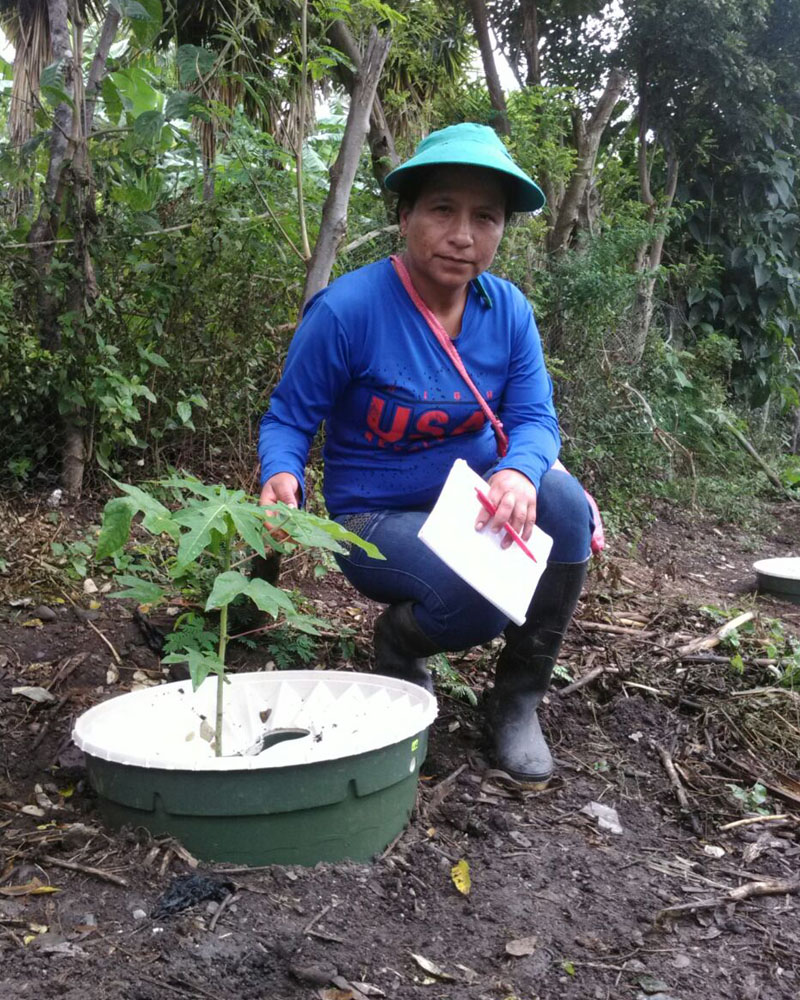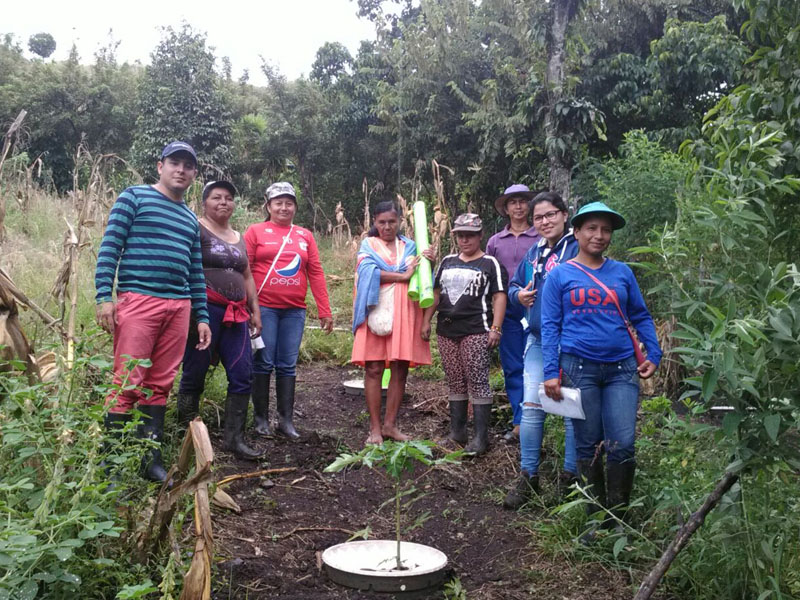Second time monitoring of the plant areas
Monday, April 23
AREA 1 – PITAYAS
This group has planted 105 Waterboxx® plant cocoons + 2 control groups = 107 Tahiti lemon trees. The general water saving is 99%. The general mortality is 0%. The control group is in good condition.
Recommendations and/or observations in Pitayas:
- Fertilization, with the aim of improving the soil, it is necessary to add substrate or any type of fertilizer available in the area and thus provide greater water retention, permeability and good drainage for the tree;
- Manual pruning of leaves.
AREA 2 – HERRADURA
This group has planted 50 Waterboxx® plant cocoons with passion fruits + 1 control group. The general water saving is 100%. The general mortality of plants with the Waterboxx® is 0%. The control group has no leaves and is withered.
Recommendations and/or observations in Herradura:
- Prune trees from the ground, to obtain luminosity (rays of the sun).
- Fertilization, with the aim of improving the soil, it is necessary to add substrate or any type of fertilizer available in the area and thus provide greater water retention, permeability and good drainage for the tree.
AREA 3 – RUIZ
This group has planted 30 Waterboxx® plant cocoons with papayas + 1 control group. The general water saving is 100%. The general mortality of the plants in the Waterboxxes is 17% (5 papayas died). The control group is withered and has no leaves since the first monitoring.
Recommendations and/or observations in Ruíz:
- Perform clearing, planting throughout the farm to avoid the presence of pests;
- Make drainage to avoid floods, due to the presence of rain characteristic of the season;
- Fertilization, with the aim of improving the soil, it is necessary to add substrate or any type of fertilizer available in the area and thus provide greater water retention, permeability and good drainage for the tree;
- Although no fertilizer has been used since sowing, in the cultivation of papaya there is a very significant growth in 90% of the seedlings. For this reason, it is necessary to remove the Waterboxx® because the papayas are already reaching the stem thickness and the plant cup that could be affected by the little space inside the box.

Sandra, leader of Tarabita 1 with her planted papaya, in Ruíz
Tuesday, April 24
AREA 4 – YUNGA
The first property is next to the road, the second property is next to the school with a dimension of 1/2 hectare with medlars, mango trees and guabo. This group has planted 80 Waterboxx® plant cocons in total with avocados and lemons + 1 control group. The general water saving is 100%. The general mortality of plants in the Waterboxxes is 0%. The control group is in good condition.
Recommendations and/or observations in Yunga:
- The beneficiaries of Yunga, considered the recommendations given in the first monitoring: they carried out fertilization and fumigation, for which it does not present difficulty with pests or diseases;
- As the only recommendation in this second control visit: pruning of trees near the land is requested in order to allow light to enter the plants;
- Remove the Growsafes of the lemons due to the opaqueness of their leaves and for the proper development of secondary branches that benefit their process of photosynthesis.
AREA 5 – ALTILLO
This group has planted 60 Waterboxx® plant cocoons with avocados and lemons + 1 control group of avocado. The general water saving is 99%. The general mortality is 2% (1 avocado died). The control group of avocado is in good condition.
Recommendations and/or observations in Altillo:
- The Altillo group is one of the most dedicated and fulfilled. They made all the recommendations given in the first monitoring: the plants were fertilized for the second time with cuyinase, fumigated with garlic and chili pepper and located the Waterboxx® that were in poor condition;
- As a single recommendation: place the Growsafe in the lemons to tutor them and benefit their vertical growth;
- Some avocados present fall of their leaves, due to the drastic change of temperature where the women indicate totally sunny day and sudden precipitations. These plants present bud of their leaves without slowing their growth.
AREA 6 – YACUANAS BAJO
This group has planted 50 Waterboxx® plant cocoons with avocados and lemons + 1 control group of avocado. The general water saving is 100%. The general mortality is 0%. The control group of avocado, is in good condition.
Recommendations and/or observations in Yacuanas Bajo:
- The Yacuanas group carried out all the recommendations given in the first monitoring;
- Only, it is suggested that the lemons be pruned and the ground cleaned to avoid pests and weeds.
Wednesday, April 25
AREA 7 – ELVECIA
This group has planted 65 Waterboxx® plant cocoons with passion fruits + 1 control group. The general water saving: 100%. The general mortality is 0%. The control group is in good condition. But, 3 passion fruit plants have mysteriously disappeared: # 271, 273, 275 of Angélica.
Recommendations and/or observations in Elvecia:
- The Elvecia group has made all the recommendations given in the first monitoring: cleaning terrain, fumigation and fertilization;
- However, there is still a presence of a loggerworm, so it is necessary to fumigate at least two more times, for total control.
AREA 8 – GONZALO
This group has planted 65 Waterboxx® plant cocoons with passion fruits + 1 control group. The general water saving is 100%. The general mortality is 0%. The control group is still small.
Recommendations and/or observations in Gonzalo:
- The cultivation of maracuya in Gonzalo is the most developed, without problems of pests or diseases and with good fertilization. The positions for the tutorado are already carried out and they only have pending the acquisition of the wire for its installation in maximum 15 days according to the height of the plant;
- It is recommended to remove the Waterboxx® for a new sowing of fruit trees.
AREA 9 – PALIZADA
This group has planted 90 Waterboxx® plant cocoons with passion fruits + 1 control group. The general water saving is 100%. The general mortality is 0%. The control group is in good condition.
Recommendations and/or observations in Palizada:
- The Palizada group has made all the recommendations given in the first monitoring: fumigation and fertilization, so the crop presents new leaves, significant growth and fertilization;
- The only thing that is stressed is: they must make postures for the tutor of passion fruits.
Thursday, April 26
AREA 10 – TARABITA 1
Tarabita 1 is divided into two properties: the first property is next to the road and is 90% flat, small inclinations. Waterboxxes #1 - 50 are planted here with Tahiti lemon trees. In addition, there is a lemon control group Tahiti. The general water saving is 100%. The general mortality is 0%. The control group is in good condition.
Recommendations and/or observations in Tarabita 1 – first property:
- In Tarabita 1 group 1, all the recommendations given in the first monitoring were made: plating in the area, fumigation, no presence of pests and diseases, and fertilization;
- The improvement is evident, compared to the first visit made.
The second group has received 80 Waterboxx® plant cocoons, divided into: 3 avocados, 21 lemons, 56 papayas. Additional, they have 2 papaya Control group. The general water saving is 100%. The general mortality is 6% (5 papayas). The control groups are small and withered.
Recommendations and/or observations in Tarabita 1 – second property:
- In the second group of Tarabita 1, cleaning or silting of the area is recommended;
- Finish the fertilization;
- There is no presence of pests or diseases;
- 5 papaya seedlings are dead;
- The rest of the plantation presents good condition and new leaves.
AREA 11 – TARABITA 2
This group has planted 80 Waterboxx® plant cocoons with 40 Lemon Tahiti + 41 Avocados (1 control group). The general water saving is 100%. The general mortality is 1% (1 avocado). The control group is small and withered.
Recommendations and/or observations in Tarabita 2:
- In the Tarabita 2 group, the incidence of the loggerworm was evidenced, for which a new fumigation is necessary for the control (preventive);
- Seedlings present new leaves;
- Fertilization is necessary, as indicated in the first monitoring.

The group of Tarabita during the second monitoring
Friday, April 27
This group has planted 105 Waterboxx® plant cocoons and 106 plants of Mora Castilla were delivered. The general water saving is 100%. The general mortality of plants is 12% (13 plants). The control group is dead. This group had overseeding of 95 blackberry seedlings on April 10.
Recommendations and/or observations in Hato Viejo:
- Fertilization, with the aim of improving the soil, it is necessary to add substrate or any type of fertilizer available in the area and thus provide greater water retention, permeability and good drainage for the tree (recommendation given from the first monitoring);
- The seedlings have leaf fall, however they already present new shoots and the green stem, which it is strengthening with the application of urea to contribute to the rapid presence of new leaves (plant in germination);
- High temperatures on the site and lack of rains;
- In this crop there is a mortality of 13 seedlings.
AREA 13 – GABRIELAS
Gabrielas has been divided into two groups. The first group is 10 minutes from the main road. The second group is a slightly inclined property. In total, 80 Waterboxx® plant cocoons have been planted with Mora Castilla + 1 control group. The general water saving is 100%. The general mortality is 10% (8 plants). The control group was the first to disappear. This group had overseeding of 47 blackberry seedlings on April 10.
Recommendations and/or observations in Gabrielas – both groups:
- The group of Gabrielas needs to carry out the fertilization recommended in the first monitoring;
- Seedlings with buds and new leaves;
- There are 10 dead seedlings.
How can we achieve better fruit tree planting results?
Below are the general comments so far, it is a summary of the second observations that are listed above.
- With the exception of the blackberries of Hato Viejo and Gabrielas, the development of the other species is within the established parameters;
- We continue to perform monthly personalized monitoring and weekly phone calls, especially with Hato and Gabrielas;
- We have very committed and responsible groups. But likewise, we have others to whom we must constantly "follow up", so that they comply with all the recommendations;
- Currently, the rains are scarce, and the days are very sunny and hot giving way to the summer of the area;
- The saving in water consumption is 100;
- We have a general mortality of 3%;
- The plants that are without leaves already have new shoots;
- The Growsafes have been removed in their entirety, in all species, claiming that their presence withered or yellowish leaves;
- In some sidewalks, it is necessary the descope or pruning of the trees so that between luminosity in the cultures as well as a pair of fumigations more to control to the 100% the presence of crickets or worms cutters;
- Lemons mostly need training pruning, to fortify the plants;
- In Elvecia, there are 3 missing plants. Interestingly, they correspond to the same beneficiary.
Two important topics, Remove of the Waterboxx® plant cocoon:
- Remove of Waterboxx®: because of the growth stimulance that the Waterboxx® is giving, in the sidewalks the maracuya and the papayas are already in tutoring time, it is necessary to remove the Waterboxx®;
- Must coordinate with each leader, the removal of the boxes, which must be cleaned and disinfected to make a new sowing of fruit trees;
- The Waterboxx® will be reused as well as the anti-evaporation plate. Only the wick is going to be discarded. I have wicks in Almaguer's room, so we can do the reinstallment of wicks without problem;
- Once cleaned, they are stacked and kept in a warehouse (which can be in the house of their leaders, so they do not get lost) until we coordinate the new sowing;
- The objective of this is: to prove that the Waterboxx® is reusable in fruit trees twice a year, and to demonstrate the advantages of Technology both in the rainy season and in the dry season;
- There are several ways of protecting the tree after removing the Waterboxx®. We start with the most preferable way to the least preferable way;
- By taking out the Waterboxx®, beneficiaries can do any of the following steps so that the plant is protected and not dehydrated;
- When taking out the Waterboxx®, 5 centimeters of old manure is placed (because new manure has salt), then straw and the plant is surrounded with stones;
- When taking out the Waterboxx®, 5 centimeters of old manure is placed (because new manure has salt), then straw and on this 10 centimeters of earth;
- When removing the Waterboxx®, 5 centimeters of old manure is placed (because new fertilizer has salt), then straw and on this 10 centimeters of vegetative material;
- In all cases the plant must be fertilized. The beneficiaries decide which option they prefer.
Fertalization:
- It is necessary to insist with the fertilization of the plants, to accelerate their growth and development. However, the paths do it empirically and we do not have the results we want;
- For this reason, Jeyson Castaño plans to carry out training and general practice of organic fertilizers where the beneficiaries will provide natural materials from their farms such as litter, earth, dung (guinea pig, rabbit, cattle, horses), crop residues (coffee or corn) and ash, in order to make bocashi fertilizer;
- This will be a great support for the participants and there would be a knowledge for future projects in favor of our field.















